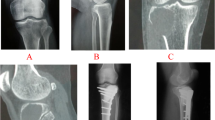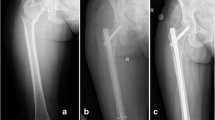Abstract
Giant cell tumours are rare bone tumours that are characteristically benign but locally aggressive, most frequently occurring in the distal femur with pathological fractures being common. This paper investigates relationships between tumour size and cortical breach on initial X-rays and subsequent treatment. The X-rays of 54 patients with distal femoral giant cell tumours were reviewed. The volumes of the tumour, distal femur and a ratio between the two parameters were estimated. The presence of a cortical breach, discrete fracture and Campanacci grade was recorded. X-rays revealed intact cortical rim in 20 patients (37%), cortical breach in 22 patients (41%) and discrete fracture in 12 patients (22%). There was a significant difference in the ratio of tumour volume to distal femoral volume between the discrete fracture group and the cortical breach group. No significant differences in rates of local recurrence were demonstrated. Extended curettage was effective for intact and cortical breach groups; however, patients in the fracture group often required radical treatment.
Résumé
Les tumeurs à cellules géantes sont des tumeurs rares et dont la caractéristique est d’être à la fois bénigne et agressive localement. Elles surviennent le plus fréquemment au niveau de l’extrémité inférieure du fémur entraînant des fractures pathologiques. Ce travail a pour but de mettre en relation certaines caractéristiques de la tumeur, taille, effraction corticale, en fonction des radios initiales et du traitement pratiqué. 54 patients présentant une tumeur à cellules géantes de l’extrémité inférieure du fémur ont été revus. Une relation a été établie entre le volume de la tumeur et le volume de l’extrémité inférieure du fémur de même que la présence d’une effraction corticale ou d’une discrète fracture. La classification de Campanacci a été utilisée. Résultats : les radios ont révélé qu’il existait une corticale intacte chez 20 patients (37% des cas), une effraction corticale chez 22 patients (41% des cas) et une discrète fracture chez 12 patients (22% des cas). Il existe des différences significatives dans la relation du volume tumoral osseux et fémoral distal pour les patients présentant une effraction corticale ou une discrète fractur. Par contre, nous n’avons pas retrouvé de différences significatives de ces éléments pour les récidives locales. Un curetage extensif est nécessaire et suffisant pour les patients présentant une corticale intacte ou une effraction corticale par contre, chez les patients présentant une fracture, il est souvent nécessaire de faire un traitement radical.


Similar content being viewed by others
References
Schajowicz F (1993) Histological typing of bone tumours. Springer, Berlin Heidelberg New York, pp 20–22
Turcotte RE, Wunder JS, Isler MH, Bell RS, Schachar N, Masri BA, Moreau G, Davis AM (2002) Giant cell tumor of long bone: a Canadian sarcoma group study. Clin Orthop Relat Res 1(397):248–258
Szendröi M (2004) Giant-cell tumour of bone. J Bone Jt Surg [Br] 86-B:5–12
Campanacci M (1990) Giant cell tumor. In: Gaggi A (ed) Bone and soft-tissue tumors. Springer, Bologna, pp 117–153
Unni KK (1998) Dahlin’s bone tumors: general aspect and data on 11087 cases, 5th edn. Lippincott-Raven, Philadelphia
Goldenberg RR, Campbell CJ, Bonfiglio M (1970) Giant cell tumour of bone: an analysis of 218 cases. J Bone Jt Surg [Am] 52-A:619–664
Larsson SE, Lorentzon R, Boquist L (1975) Giant cell tumor of bone: a demographic, clinical and histopathological study of all cases recorded on the Swedish Cancer Registry for the years 1958 to 1968. J Bone Jt Surg [Am] 57-A:167–173
McInerny DP, Middlemiss JH (1978) Giant cell tumour of bone. Skelet Radiol 2:195–204
Sung HW, Kuo DP, Shu WP et al (1982) Giant cell tumour of bone: an analysis of 218 cases in Chinese patients. J Bone Jt Surg [Am] 64-A:755–761
Komiya S, Inoue A, Nakashima M et al (1986) Prognostic factors in giant cell tumour of bone: a modified histological grading system as a useful guide to prognosis. Arch Orthop Trauma Surg 105:67–72
MacDonald DJ, Sim FH, McLeod RA, Dahlin DC (1986) Giant cell tumour of bone. J Bone Jt Surg [Am] 68-A:235–242
Campanacci M, Baldini N, Boriani S, Sudanese A (1987) Giant cell tumour of bone. J Bone Jt Surg [Am] 69-A:106–114
Szendroi M (1990) Giant cell tumour of the radius: aggressiveness and soft tissue recurrence. Chir Organi Mov 75[Ssuppl 1]:241–243
Miller G, Bettelli G, Fabbri N, Campanna R (1990) Curettage of giant cell tumor of bone: introduction, material and methods. Chir Organi Mov 75[Suppl 1]:203
Dreinfhöfer KE, Rydholm A, Bauer HCF, Kreicbergs A (1995) Giant-cell tumours with fracture at diagnosis. J Bone Jt Surg [Br] 77-B:189–193
Jaffe HL, Lichtenstein L, Portis RB (1940) Giant cell tumor of bone: its pathologic appearance, grading, supposed variants and treatment. Arch Pathol 30:993–1031
Dahlin DC (1978) Bone tumours, 3rd edn. Charles C Thomas, Springfield, Illinois, pp 99–115
Enneking WF (1983) Musculoskeletal tumor surgery, vol 1. Churchill Livingstone, New York, pp 1436–1476
Harrington KD, Sim FH, Enis JE, Johnston JO, Dick HM, Gristina AG (1976) Methylmethacrylate as an adjunct in internal fixation of pathological fractures. Experience with three hundred and seventy-five cases. J Bone Jt Surg 58-A:1047–1055 Dec
Keene JS, Sellinger DS, McBeath AA, Engber WD (1986) Metastatic breast cancer in the femur. A search for the lesion at risk of fracture. Clin Orthop 203:282–288
Mirels H (1989) Metastatic disease in long bones. A proposed scoring system for diagnosing impending pathologic fractures. Clin Orthop 249:256–264
Author information
Authors and Affiliations
Corresponding author
Rights and permissions
About this article
Cite this article
Jeys, L.M., Suneja, R., Chami, G. et al. Impending fractures in giant cell tumours of the distal femur: incidence and outcome. International Orthopaedics (SICO 30, 135–138 (2006). https://doi.org/10.1007/s00264-005-0061-z
Received:
Accepted:
Published:
Issue Date:
DOI: https://doi.org/10.1007/s00264-005-0061-z




